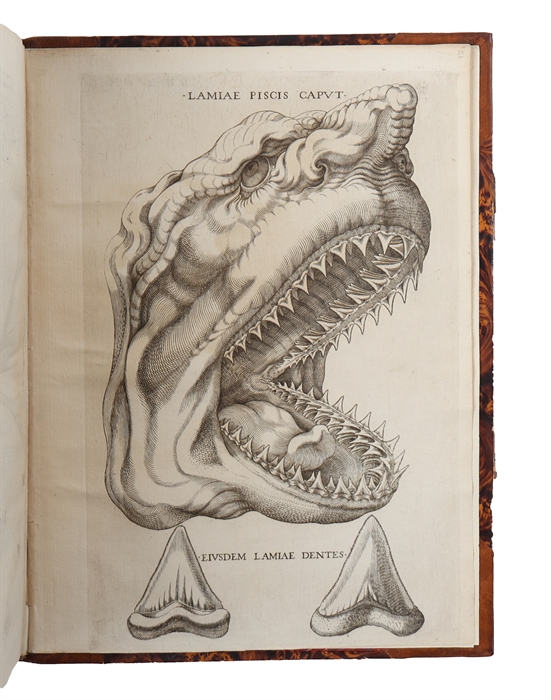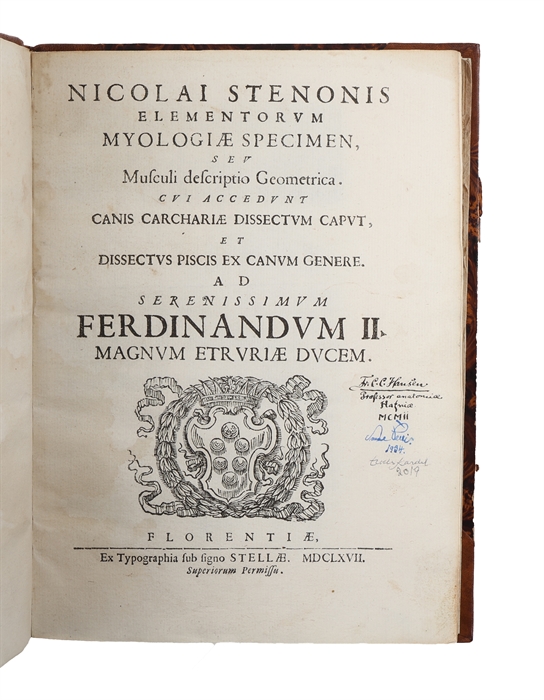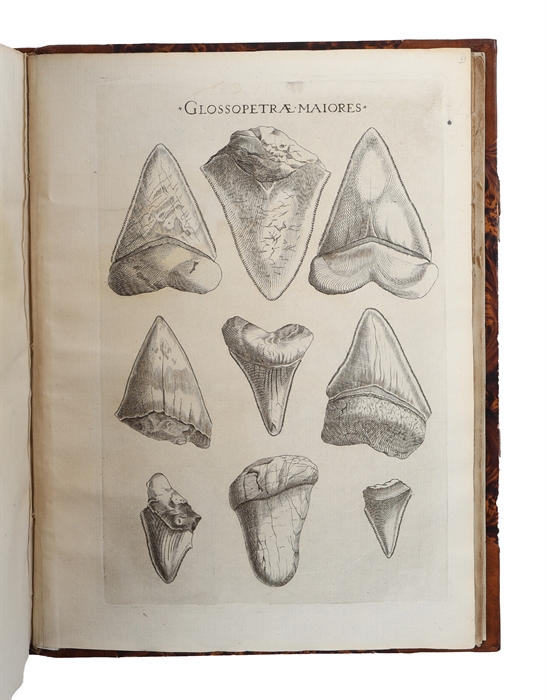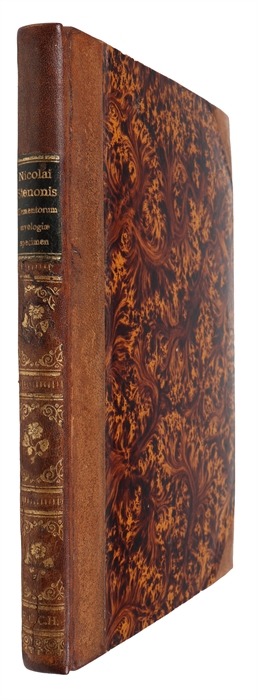"THE FIRST OUTLINE OF A SCIENTIFIC THEORY OF THE DEVELOPMENT OF THE EARTH"
STENO, NICOLAI (STENONIS, NILS STENSEN).
Elementorum myologiae specimen, seu musculi descriptio geometrica. Cui accedunt canis carchariae dissectum caput, et dissectus piscis ex canum genere.
Florenze, (J. Cocchini) sub signo Stellae, 1667.
4to (230 x 165 mm). Early 19th century brown half calf, rebacked and neatly restored, preserving most of the early spine. Newer endpapers. Gilt spine with gilt leather title-label. "F.C.C.H" (Frederik Carl Christian Hansen) in gilt lettering to lower part of spine. Vague dampstain to lower and outer margins of first half of bookblock. Margins washed and leves K-P2 possibly neatly restored at blank margin without loss of paper and without touching text. Vague dampstain to plates also, mostly visible from verso, barely from recto. Woodcut arms of the Medici-family on the title-page.
(2 blanks), (8), 123, (1 blank) pp. + 7 plates: 3 large folding woodcut plates numbered Tabula I-III and 4 full page engraved plates.
With previous ownership signatures and dates to title-page:
"Fr. C.C. Hansen / Professor anatomiae / Hafniae. / MCMii", being the Danish anatomist Frederik Carl Christian Hansen (1870 - 1934).
- "Svend Petri. / 1934."
- "Troels Kardel / 2019", being Troels Johan Dahler Kardel (1940 - 2024) - Doctor of Medicine and one of the most renowned 20th-century Steno scholars. As co-author, alongside Belgian scholar Paul Maquet, of a major critical edition and biography of Steno, Kardel played a key role in reviving scholarly interest in "Elementorum Myologiae Specimen" and reestablishing its significance within the history of science.
Notably, Kardel was received in audience by Pope John Paul II at the Vatican, a testament not only to his scholarly standing but also to the cultural and spiritual relevance of Steno who is venerated in the Catholic Church and beatified in 1988.
First edition, with an interisting provenance, of Steno’s landmark work in the history of science, introducing several groundbreaking discoveries across multiple fields of science, particularly anatomy, geology, and the philosophy of science. Steno was the first to demonstrate that muscles do not increase in volume when they contract. This refuted the longstanding Galenic theory and laid the foundation for modern muscle physiology. With the present work, Steno fully developed his developed his groundbreaking muscle theory and revolutionized our knowledge of how the muscles function. He also included comparisons between animal and human anatomical structures, helping to establish the discipline of comparative anatomy and opening new pathways for later evolutionary thought. It as also in the present work that Steno, through the dissection of a shark's head, successfully identified "tongue stones" as fossilized shark teeth, which directly contradicted earlier beliefs that fossils formed spontaneously in rocks. This marked a foundational moment in paleontology and stratigraphy helping to establish that fossils are remains of once-living organisms, thereby setting the stage for his later geological principles (in “De solido intra solidum naturaliter contento”, 1669), such as the principle of original horizontality and superposition. “The first part of Stensen’s "Elementorum" elaborates upon the concepts introduced in his "De musculis et glandulis", laying the foundation of muscular mechanics. In collaboration with the mathematician Vincenzo Viviani, a pupil of Galileo, Stensen developed a geometrical description of muscular contraction, and attempted to show theoretically that muscles did not increase in volume during contraction. Dealing with his subject on a strictly mechanical basis, he gave a clear terminology for the parts of the muscle and characterized muscle and muscle fiber according to their geometrical structure. He recognized that muscle tension was the result of the individual forces of its constituent fibers and was thus able to refute the views of Borelli, who believed that a muscle’s hardness and swelling during contraction was due to the influx of nerve fluid. The remainder of the treatise includes Stensen’s account of his dissection of a shark’s head. In discussing the relationship of the shark teeth to similar-shaped fossil stones found in the Mediterranean, Stensen developed theories of how geological structures and fossils might be formed. This has been called the first outline of a scientific theory of the development of the earth. The Elementorum also contains two of Stensen’s embryological contributions, his recognition of the egg-producing function of the mammalian ovary and his description of the placenta in the viviparous shark.” (Norman 2012). “A Danish physician, geologist, and clergyman, Steno studied medicine at Copenhagen, Leiden and Paris. He settled in Italy, first as professor of anatomy at Padua and then in Florence as house physician to Grand Duke Ferdinand II. He served for at brief time as professor and royal anatomist in Copenhagen. Dissatisfied, he returned to Florence where he abandoned his scientific career and entered the priesthood, eventually becoming bishop.” (Heirs of Hippocrates) The present work is a superb testament to Steno’s multifaceted life and eclectic career, revolutionizing several different branches of science. His fundamental scientific method applied here also reveals Steno as, not only a brilliant observer, but also a methodological pioneer, who helped shape how science was conducted in the early modern period. Norman 2012
Steno studied rock formations and concluded that all rocks and minerals were once fluid, settling into horizontal layers over time. These layers could trap and preserve animal remains as fossils with older layers at the bottom and newer ones on top - a principle now known as Steno’s Law of Superposition. While others had suggested that fossils were once-living organisms, Steno advanced the idea by linking fossils to specific moments in Earth’s history and showing that rock layers formed gradually. His insights laid the foundation for modern geology and paleontology helping to reveal how life evolved over billions of years.
Garrison-Morton 577
Osler 4021
Waller 9223
Barchas 1994
Order-nr.: 62354




